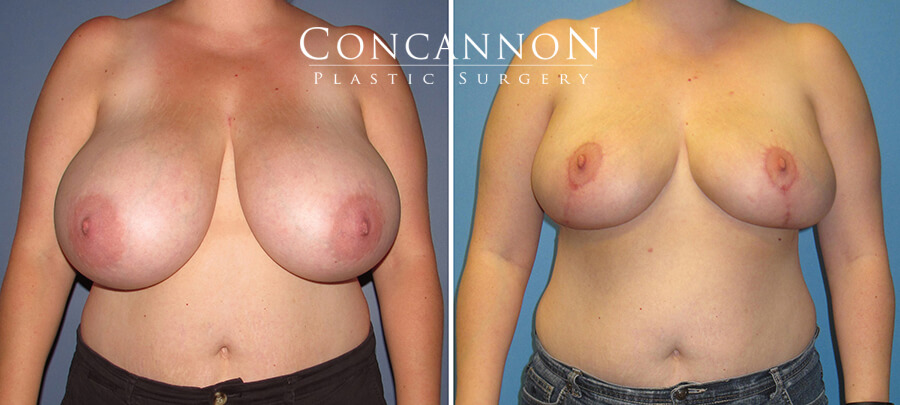Breast Reduction
If You're Considering Breast Reduction
Women with very large, pendulous breasts may experience a variety of medical problems caused by the excessive weight-from back and neck pain and skin irritation to skeletal deformities and breathing problems. Bra straps may leave indentations in their shoulders. And unusually large breasts can make a woman—or a teenage girl—feel extremely self-conscious.

General Information
Breast reduction, technically known as reduction mammaplasty, is designed for such women. The procedure removes fat, glandular tissue, and skin from the breasts, making them smaller, lighter, and firmer. It can also reduce the size of the areola, the darker skin surrounding the nipple. The goal is to give the woman smaller, better-shaped breasts in proportion with the rest of her body.
If you’re considering breast reduction, this will give you a basic understanding of the procedure- when it can help, how it’s performed, and what results you can expect. It can’t answer all of your questions, since a lot depends on your individual circumstances. Please be sure to ask Dr. Concannon if there is anything about the procedure you don’t understand.

The Best Candidates for Breast Reduction
Breast reduction is performed for physical relief as well as for cosmetic improvement. Most women who have the surgery are troubled by very large, sagging breasts that restrict their activities and cause them physical discomfort.
In most cases, breast reduction isn’t performed until a woman’s breasts are fully developed; however, it can be done earlier if large breasts are causing serious physical discomfort. The best candidates are those who are mature enough to fully understand the procedure and have realistic expectations about the results.
All Surgery Carries Some Uncertainty and Risk
Breast reduction is not a simple operation, but it’s normally safe when performed by a qualified plastic surgeon. Nevertheless, as with any surgery, there is always a possibility of complications, including bleeding, infection, or reaction to the anesthesia. Some patients develop small sores around their nipples after surgery; these can be treated with antibiotic creams. You can reduce your risks by closely following Dr. Concannon’s advice both before and after surgery.
The procedure does leave noticeable, permanent scars, although they’ll be covered by your bra or bathing suit. (Poor healing and wider scars are more common in smokers.) The procedure can also leave you with slightly mismatched breasts or unevenly positioned nipples.
Some patients may experience a permanent loss of feeling in their nipples or breasts. Rarely, the nipple and areola may lose their blood supply and the tissue will die. (The nipple and areola can usually be rebuilt, however, using skin grafts from elsewhere on the body.) These risks are much greater in women who smoke; for that reason Dr. Concannon does not perform this procedure on active smokers.
Planning Your Surgery
In your initial consultation, it’s important to discuss your expectations frankly with Dr. Concannon , and to listen to his opinion of what you may be able to expect from this surgery. Every patient-and every physician has a different view of what is a desirable size and shape for breasts.
Dr. Concannon will examine and measure your breasts, and will photograph them for reference during surgery and afterwards. (The photographs may also be used in the processing of your insurance coverage.) He will discuss the variables that may affect the procedure-such as your age, the size and shape of your breasts, and the condition of your skin. You should also discuss where the nipple and areola will be positioned; they’ll be moved higher during the procedure, and should be approximately even with the crease beneath your breasts.
Dr. Concannon will describe the procedure in detail, explaining its risks and limitations and making sure you understand the scarring that will result. This procedure is performed under a general anesthetic (you are asleep), and takes approximately 2 hours to do. Dr. Concannon will discuss the facility where the surgery will be performed, and the costs. Some insurance companies will pay for breast reduction if it’s medically necessary; however, they may require that a certain amount of breast tissue be removed. If Dr. Concannon feels that in your situation the procedure is medically indicated (vs. only cosmetic in nature) he will write a “predetermination letter” to your insurance company to verify that the surgery will be covered.
Preparing for Your Surgery
Dr. Concannon may ask that you to have a mammogram (breast x-ray) before surgery. You’ll also get specific instructions on how to prepare for surgery, including guidelines on eating and drinking.
While you’re making preparations, be sure to arrange for someone to drive you home after your surgery and to help you out for a few days if needed.
Where Your Surgery Will be Performed
Breast reduction surgery may be performed in a hospital or at an outpatient surgery center. If you are admitted to the hospital, your stay will be a short one; anticipate an overnight stay prior to returning home.
Type of Anesthesia
Breast reduction is always performed under general anesthesia. You’ll be asleep through the entire operation.
Photo Gallery
Vew the results of previous patients on
Dr. Concannon’s extensive photo gallery
The Surgical Procedure
Techniques for breast reduction vary, but the most common procedure involves an anchor-shaped incision that circles the areola, extends downward, and follows the natural curve of the crease beneath the breast. Dr. Concannon removes excess glandular tissue, fat, and skin, and moves the nipple and areola into their new position. He then brings the skin from both sides of the breast down and around the areola, shaping the new contour of the breast.
Stitches are located around the areola, in a vertical line extending downward, and along the lower crease of the breast.
After Your Surgery
After surgery, you’ll be wrapped in an elastic bandage. You may feel some pain for the first couple of days-especially when you move around or cough-and some discomfort for a week or more. Dr. Concannon will prescribe medication to lessen the pain.
The bandages will be removed a day or two after surgery, though you’ll continue wearing the surgical bra around the clock for several weeks, until the swelling and bruising subside. Your stitches will be removed in three weeks.
If your breast skin is very dry following surgery, you can apply a moisturizer several times a day, but be sure to keep the suture area dry.
Your first menstruation following surgery may cause your breasts to swell and hurt. You may also experience random, shooting pains for a few months. You can expect some loss of feeling in your nipples and breast skin, caused by the swelling after surgery. This usually fades over the next six weeks or so. In some patients, however, it may last a year or more, and occasionally it may be permanent.
YOUR NEW LOOK
Although much of the swelling and bruising will disappear in the first few weeks, it may be six months to a year before your breasts settle into their new shape. Even then, their shape may fluctuate in response to your hormonal shifts, weight changes, and pregnancy.
Dr. Concannon will make every effort to make your scars as inconspicuous as possible. Still, it’s important to remember that breast reduction scars are extensive and permanent. They often remain lumpy and red for months, then gradually become less obvious, sometimes eventually fading to thin white lines. Fortunately, the scars can usually be placed so that you can wear even low-cut tops.
Of all plastic surgery procedures, breast reduction results in the quickest body-image changes. You’ll be rid of the physical discomfort of large breasts, your body will look better proportioned, and clothes will fit you better.
However, as much as you may have desired these changes, you’ll need time to adjust to your new image-as will your family and friends. Be patient with yourself, and with them. Keep in mind why you had this surgery, and chances are that, like most women, you’ll be pleased with the results.

